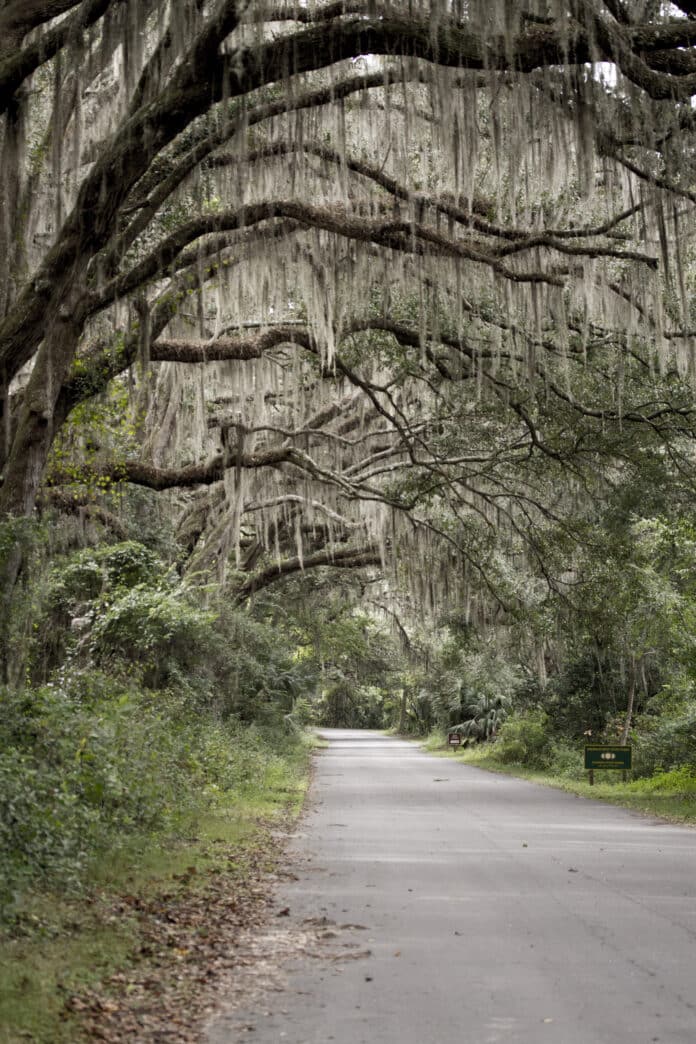Did you know?
-
Spanish moss is neither Spanish nor a moss.
-
Spanish moss is not a parasite; it gets all its nutrients from the air and rainwater.
-
Spanish moss has a key role in Florida’s ecology.
Spanish moss is common in our area, and people often wonder if it harms our trees. Contrary to widely held belief, Spanish moss is not a parasite. It is an epiphytic plant that grows on another plant but does not utilize the host plant for nutrients. Epiphytes, sometimes known as “air plants”, get all their nutrients from the air and rainwater, and they make their own food. Spanish moss does not have any roots. It uses its long, scaly stems to wrap around the host tree and hang down from the branches. The stems are covered with cup-like, permeable scales that retrieve moisture and nutrients from the air and from pockets on the surface of trees. The plant’s tissues can hold more water than it needs, so it can withstand long dry periods, and in extreme droughts, it becomes dormant until moisture returns. When the tissues plump up after a rain, Spanish moss appears greenish, and as the water is used, it returns to a gray hue.
Spanish moss is not a type of moss; it is a bromeliad, related to pineapples and many popular houseplants. It does not exist in Spain but is native to Central and South America and the southeastern US. Native Americans called it Itla-okla, which meant “tree hair”, but early French explorers thought it looked like the Spanish conquistadors’ long beards, so they called it “Spanish Beard”. One story is told of a Spaniard named Gorez Goz who bought a Native American maiden for a yard of braid and a bar of soap. She ran away from him and he chased her to the top of a tree. The maiden dove into the water and escaped, but Goz’s long beard got tangled in the tree, and there he died, resulting in the “greybeard” that we see in trees today. Over time, Spanish beard became Spanish moss.
Spanish moss produces tiny seeds with feathery appendages that allow them to float through the air, but it is more likely to propagate from fragmented pieces carried by birds or the wind. Many animals use Spanish moss for protection, taking cover in the thick masses. Several species of songbirds use the plant material for nest building or weave their nests in clumps of moss. Warblers are especially fond of these sites, as are bats. Many reptiles, amphibians, insects and mites (especially chiggers) are common residents in Spanish moss, especially on the ground, so be careful if you handle it. While the plant is not parasitic, heavy accumulations can weigh down branches and over-shade existing foliage. Dead and declining trees generally have numerous bare branches that easily catch wind-blown moss, while healthy trees generally outgrow any moss that lands on them. You do not need to remove Spanish moss from your trees, but if you do not like the look, use gloves or a hook to remove any accumulations.
Spanish moss has had many uses. Native American women made dresses from it. American colonists mixed it with mud to make mortar for their houses, some of which are still standing. Dried moss has been made into blankets, rope and stuffing material in automobile seats, furniture, and mattresses. Today, it is used as tinder for fires, packing material, and garden mulch. It is widely used in the floral industry as decorative material and to hold in moisture around the base of plants.
For answers to your gardening questions, contact UF IFAS Extension Hernando County at 352-754-4433, (http://sfyl.ifas.ufl.edu/hernando/). Master Gardeners are in Lowe’s Garden Center in Spring Hill on the 1st and 3rd Saturday of each month from 10:00 to 2:00. The Master Gardener Nursery, 19490 Oliver Street, specializes in native and Florida-friendly plants and is open every Wednesday and Saturday from 9:00 am until noon. Extension programs are open to all persons without regard to race, color, sex, age, disability, religion, or national origin.
Sources: Florida Forest Plants – Spanish Moss (http://www.sfrc.ufl.edu/extension/4h/plants/Spanish_moss/

